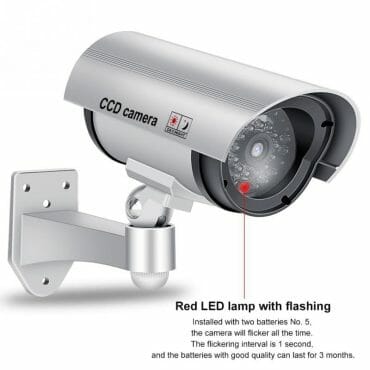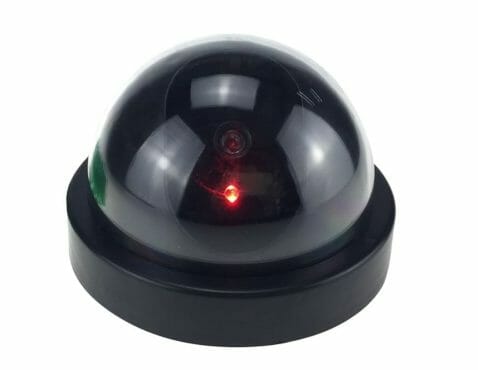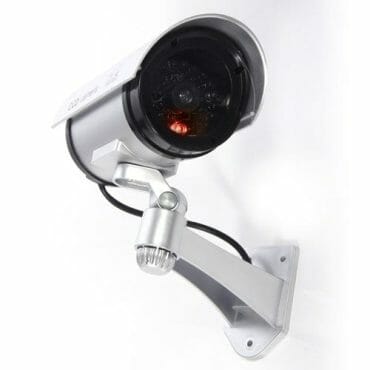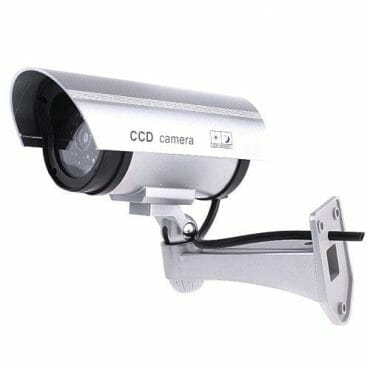Quick Navigation
There are many steps you can take to keep your property safe. Today, let’s focus on just one: security cameras. Before going further, it’s important to look at why security cameras are important and the benefit and drawbacks of fake varieties.
Does the Presence of Security Cameras Matter?
 According to ResearchGate data that surveyed 422 randomly selected incarcerated male and female burglars, one important step people can take to keep their property safe is a security system, including outdoor security cameras. In fact, when those surveyed were asked what deterred them from targeting specific locations, the presence of a security system was noted as one vital reason they would seek an alternative target.
According to ResearchGate data that surveyed 422 randomly selected incarcerated male and female burglars, one important step people can take to keep their property safe is a security system, including outdoor security cameras. In fact, when those surveyed were asked what deterred them from targeting specific locations, the presence of a security system was noted as one vital reason they would seek an alternative target.
In other words, they wouldn’t even attempt to steal from properties with high-level security systems. The reason is obvious because security cameras can instantly capture a thief’s image, making it much easier for law enforcement to find and arrest the perpetrator for the crime.
Of course, this fact has led many homeowners and business owners to install dummy security camera in the hope of tricking burglars by creating the illusion of a security system. Let’s go over what it takes to spot or identify a fake security camera. Read on to learn more:
Six Ways to Identify Fake Security Cameras
There are six primary ways to properly identify fake security cameras or dummy CCTV cameras. They are outlined below:
-
LED Lights: Do Real Security Cameras Have a Blinking Light?
 One dead giveaway a security camera isn’t what it seems is LED lights. A real camera, like ours, will have night vision. This means a red LED will be present when ambient light is not ideal. Fake cameras won’t blink when it gets dark. Some dummy cameras or fake CCTV cameras come equipped with flashing LED lights, designed to mimic the look of the real deal.
One dead giveaway a security camera isn’t what it seems is LED lights. A real camera, like ours, will have night vision. This means a red LED will be present when ambient light is not ideal. Fake cameras won’t blink when it gets dark. Some dummy cameras or fake CCTV cameras come equipped with flashing LED lights, designed to mimic the look of the real deal.
However, most criminals can tell the difference between LED lights that come on only when necessary for video purposes and those that stay on all the time because they are battery operated and are designed to mimic the real thing. If a LED light is flashing during the daytime, this is a sure giveaway to experienced criminals that you have a dummy camera. Also, on real cameras, the LED light isn’t overpowering or too ostentatious. In dummy surveillance cameras, it can be overpowering and obvious.
-
Cheap Materials
In many cases, a fake or dummy CCTV camera simply looks cheap. Instead of having a standard waterproof aluminum cover, a fake camera will have one that’s made of cheap plastic. Most experienced criminals can easily recognize the difference between plastic and high-quality metal. This is especially true if you install your fake camera in an easy-to-reach location, like the front door.
-
Installation or Dummy Security Cameras Locations
Where people place a fake or dummy camera can also make it obvious to a thief if it’s the real deal or a knockoff. An outdoor camera undergoes exposure to wind, water and  other aspects of being outside, and a fake camera made of inferior material cannot withstand the elements for very long without breaking down or showing excessive signs of wear. This means it must be installed in a somewhat protective location, such as under ceilings or eaves.
other aspects of being outside, and a fake camera made of inferior material cannot withstand the elements for very long without breaking down or showing excessive signs of wear. This means it must be installed in a somewhat protective location, such as under ceilings or eaves.
Conversely, real cameras like ours are made of high-quality materials and are designed to withstand all that Mother Nature can throw at it, so it can be installed anywhere, even outdoors, unprotected. Therefore, it’s safe to assume that a camera installed outdoors without protection from weather elements and wear is likely real.
-
Wires
The presence of wires isn’t in and of itself an indicator of a camera being fake or not. After all, many cameras have built-in wires, and dome cameras are wire-free, which means there aren’t visible wires. Many fake cameras try to mimic the look of real cameras by adding fake wiring that sticks out.
This can fool some criminals, but many will recognize it as just another way to copy the real deal. Therefore, in many instances, the presence of wires that are made to look real, in actuality, make it obvious a camera isn’t real at all.
-
Movement and Tracking
There are motion-sensing cameras on the market today that sense motion and then record movements. However, they do not actually move or swivel when someone comes near. Conversely, in an effort to mimic the motion-sensing element of the real deal, some fake security cameras will rotate back and forth. Keep in mind, a real motion-sensing camera will usually never swivel. Instead, it will just begin recording the moment the sensor is activated.
It will record everything, but not move. A fake CCTV camera will sometimes make significant movements. Keep in mind as of right now, true movement tracking isn’t always an affordable option for most security cameras, so it’s not a common feature or even a possible one for most units. Therefore, if you see a camera moving, it’s likely a dummy security camera or a fake camera.

-
Markings or Branding
One of the easiest ways to spot a dummy camera is the lack of branding on the outside. A real security camera will feature obvious brand markings identifying it as a legitimate system. A quick internet search of a particular brand will easily reveal if it’s a real one or a fake.
That means dummy cameras that have branding can still be identified as a dummy camera. Therefore, simply noting branding does not in fact mean it’s real. It has to be a brand synonymous with real security cameras to denote a real camera. In general, real security cameras will have lots of branding displayed in a prominent location. Fake cameras won’t always involve this attention to detail.
FAQs About Security Cameras You Will Want to Know

What Is the Best Fake Security Camera?
The best fake security cameras will take the above information into account and mimic the looks, behavior, installation location and branding of real cameras. We have a few suggestions of some (either fake or authentic cameras) listed below:
How Can You Tell If a Security Camera Is On?
You obviously want to make sure your security camera is working properly, recording and on when installed. How to check this will obviously depend on the type of camera installed. If you have an IP security camera with infrared blinking red lights, you should see a small red blinking light around the camera lens.
You can also log into your security software, which is connected to your security system. This will show you live-stream footage if cameras are working properly. Also, there are usually power indicators on security cameras that will make it obvious if cameras are on and working. Sometimes these are a red light or blinking red light.
Are Dummy Cameras Illegal?
In short, no. At least in most cases, fake security cameras are not illegal. However, just like real security cameras, dummy CCTV systems or fake security cameras must adhere to various laws. For example, all cameras, fake camera or not, have to be carefully installed to avoid potential legal ramifications. Any and all cameras, even dummy varieties, that are aimed at a window or set to overlook private property can cause legal issues. In addition, there are legal ramifications in some form, relating to fake cameras if people are depending on them for security purposes.
For example, let’s assume a property owner of a condominium installed several security cameras — some real and some fake security cameras. If people were depending on each camera to provide the same level of security but later found out one camera was only a dummy, this could cause legal issues due to a false sense of security being created. An example of this could be a landlord providing a false sense of security by placing fake security cameras in a known dangerous area.
Tenants might be inclined to go to this location thinking they were protected by security systems. If the cameras included a dummy security camera, tenants weren’t aware that the cameras weren’t real and then they experienced harm in that location, the property owners could face legal ramifications, according to New York licensed lawyer Ken Kirchenbaum.
Bottom Line
To learn how to fool a would-be criminal with a fake camera, it’s important to learn and understand the characteristics of the real thing. Experienced criminals will often notice even the smallest nuances of your security system, making it that much more important that you expertly camouflage your dummy system.
If you do opt for a fake security system or one that at least utilizes a few fake cameras, understand you can’t rely on it for evidence of crimes committed or to alert you in a potentially threatening event or burglary. If you go about it with that mindset, you can successfully utilize inauthentic cameras to trick would-be burglars and discourage unlawful behavior on your property.
